The Intel SSD 320 Review: 25nm G3 is Finally Here
by Anand Lal Shimpi on March 28, 2011 11:08 AM EST- Posted in
- IT Computing
- Storage
- SSDs
- Intel
- Intel SSD 320
It's called the Intel SSD 320, but the part number should give away just what we're looking at here:
This is the long awaited third generation Intel based SSD. This is the G3. And at this point it's around 6 months late.
Back then it was simply called the Postville Refresh on Intel's roadmaps (Postville was the 34nm Intel X25-M G2). It would use 25nm Intel NAND, feature improved performance and full disk encryption - all behind a 3Gbps SATA interface.
When I spoke with Intel about the drive last year, all indications pointed to it being faster than drives based on SandForce's SF-1200 controller. And it is:
| Intel SSD 320 300GB vs. Corsair Force F120 | ||||
| AT Storage Bench 2011 (Heavy) | AT Storage Bench 2011 (Light) | |||
| Corsair Force F120 | 120.1 MB/s | 155.9 MB/s | ||
| Intel SSD 320 300GB | 132.8 MB/s | 161.7 MB/s | ||
Without turning to any real time compression/deduplication techniques, Intel has built a drive that's faster than the SF-1200. You also get that famed Intel SSD reliability:
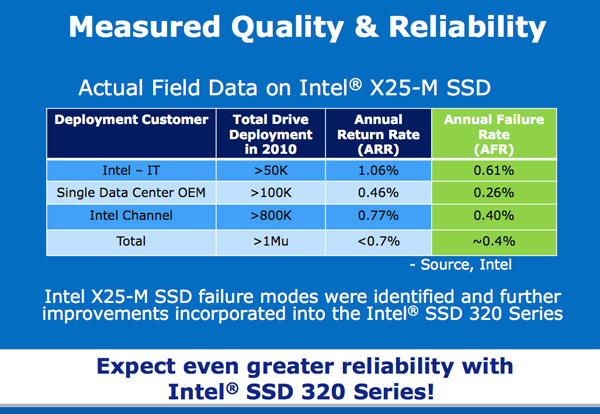
There's just one issue. The SF-1200 was the king of 2010. This year is shaping up to be all about the SF-2200 and the G3 isn't quite as competitive there. Intel realized this as well and thus we got the Intel SSD 510 to address the high performance market. Intel claims the 510 should have the same failure rate as the 34nm X25-M G2 at ~0.6% per year.
The Intel SSD 320 by comparison is aimed at the mainstream market. Remember that's what the M in X25-M always stood for to begin with. As a result we get lower pricing:
| Intel SSD Comparison | ||||||||||||
| X25-M G2 160GB | Intel SSD 320 40GB | Intel SSD 320 80GB | Intel SSD 320 120GB | Intel SSD 320 160GB | Intel SSD 320 300GB | Intel SSD 320 600GB | SSD 510 120GB | SSD 510 250GB | ||||
| User Capacity | 149GB | 37GB | 74GB | 111GB | 149GB | 279GB | 558GB | 111GB | 232GB | |||
| Random Read Performance | Up to 35K IOPS | Up to 30K IOPS | Up to 38K IOPS | Up to 38K IOPS | Up to 39K IOPS | Up to 39.5K IOPS | Up to 39.5K IOPS | Up to 20K IOPS | Up to 20K IOPS | |||
| Random Write Performance | Up to 8.6K IOPS | Up to 3.7K IOPS | Up to 10K IOPS | Up to 14K IOPS | Up to 21K IOPS | Up to 23K IOPS | Up to 23K IOPS | Up to 8K IOPS | Up to 8K IOPS | |||
| Sequential Read Performance | Up to 250MB/s | Up to 200MB/s | Up to 270MB/s | Up to 400MB/s (6Gbps) | Up to 500MB/s (6Gbps) | |||||||
| Sequential Write Performance | Up to 100MB/s | Up to 45MB/s | Up to 90MB/s | Up to 130MB/s | Up to 165MB/s | Up to 205MB/s | Up to 220MB/s | Up to 210MB/s (6Gbps) | Up to 315MB/s (6Gbps) | |||
| Price | $404 | $89 | $159 | $209 | $289 | $529 | $1069 | $284 | $584 | |||
It's still early in the 25nm ramp, but the 25nm Intel SSD 320 is cheaper than the 34nm Intel SSD 510. The only issue is that OCZ is very competitive with its pricing as well and compared to the Vertex 2, Intel's SSD 320 isn't really any cheaper. Intel likes to maintain its 65% profit margins so even though it makes the NAND and the controller in the 320, we're unlikely to see these drives drop below competitive pricing.
Intel expects the 25nm SSD 320 to be even more reliable than the 510 or X25-M.
The Same Controller
The Intel SSD 320, like the 310 and X25-M before it, uses an Intel branded controller. Opening up the 320 reveals a near identical controller to what we saw in the 34nm X25-M G2 housing:
You'll notice the part number is identical to 2009's X25-M G2 controller. In fact, it's the same controller. Apparently the G2 controller had a number of features on-die, but not implemented in firmware. Things like full disk encryption and NAND redundancy never made it out in G2 but are here in the 320 all thanks to new firmware. And no, G2 owners aren't getting it.
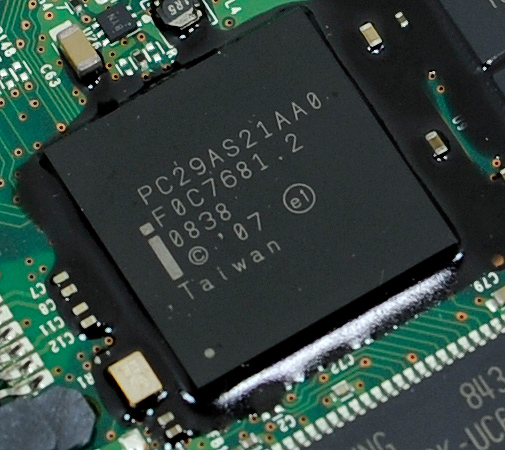
Intel's X25-M G1 Controller
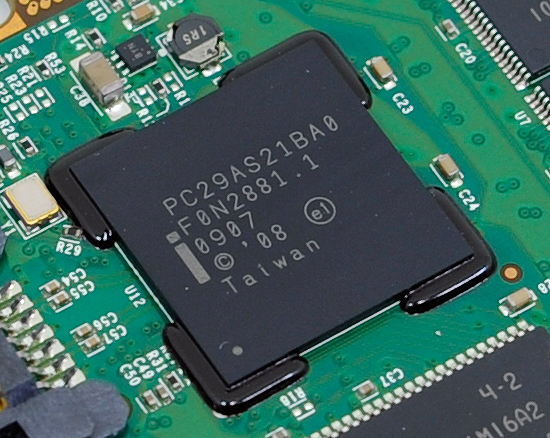
Intel's X25-M G2 Controller
Since the controller hasn't changed, the basic architecture of the SSD hasn't changed either. Intel still doesn't store any user data in its external DRAM cache and there's still a 256KB on-die SRAM.
Next to the Intel controller is a 64MB 166MHz SDRAM device, now made by Hynix. You'll notice that the DRAM chip is a lot smaller than what we've seen in previous X25-M generations, despite growing in capacity. Intel actually turned to mobile SDRAM for use in the SSD 320 to help save on power. While the X25-M G1 and G2 both used a conventional 3.3V SDRAM device, Intel moved to a 1.8V mobile SDRAM chip with the 320.
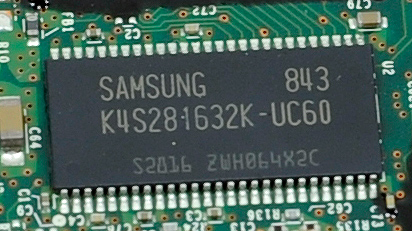
Intel X25-M G1: 16MB 166MHz SDRAM
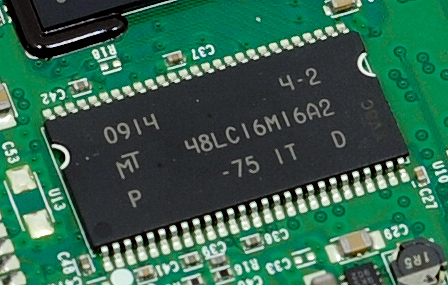
Intel X25-M G2: 32MB 133MHz SDRAM
Intel always prided itself on not storing any user data in its DRAM cache. The external DRAM is only used to cache mapping tables and serve as the controller's scratchpad. In the event of a sudden loss of power, Intel only has to commit whatever data it has in its SRAM to NAND. To minimize the amount of data loss in the event of a sudden power failure, Intel outfitted the SSD 320 with an array of six 470µF capacitors in parallel.
We've seen large capacitors on SSDs before, primarily the enterprise SandForce drives that boast a 0.09F supercap. Intel claims that for its design a single large capacitor isn't necessary given the minimal amount of data that's cached. It further claims that an array of multiple capacitors in parallel allows for much better reliability - if one capacitor fails the array is still useful (vs. a single point of failure in the case of the supercap).



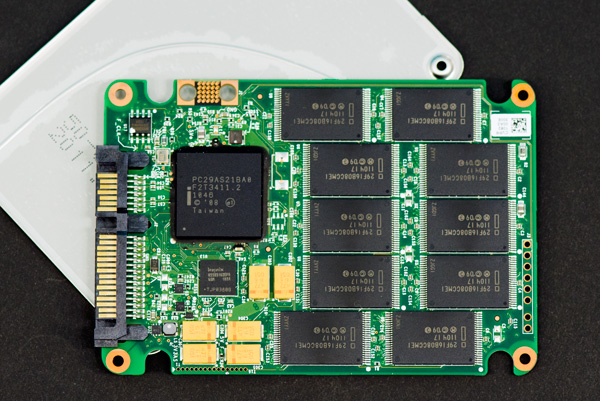
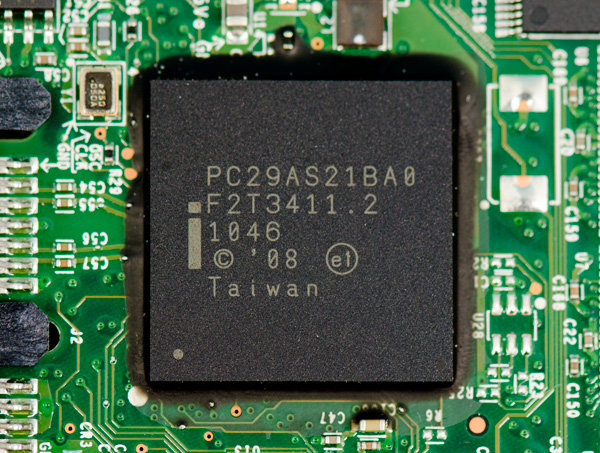
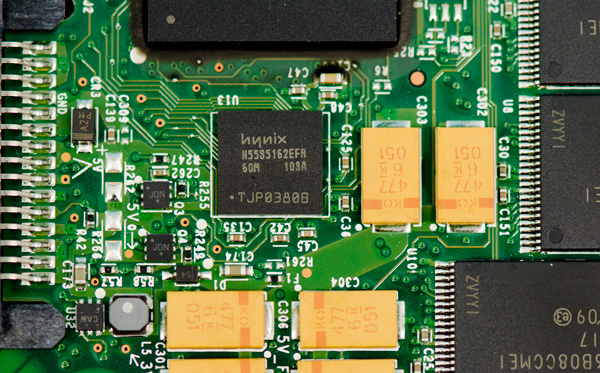









194 Comments
View All Comments
Chloiber - Tuesday, March 29, 2011 - link
True.It is true, thet the REAL capacity of flash drives is 2 based. The NAND chips are.
So a 120GB drive has in reality 128GB of flash.
So its 120/128 % spare area. The 300GB version has also 300/320 % spare area (which is exactly the same).
Anand is confusing things. The user gets 300GB, as he gets 300GB when buying a HDD. Windows on the other han is showing us "GiB" not "GB". But it's not a real difference in size. 74.5GiB EQUALS 80GB. It's the same thing. Compare the BYTE numbers if you wanna be sure, not the KB/MB/GB/TB numbers.
I'm actually shocked that this still gets confused.
overzealot - Tuesday, March 29, 2011 - link
RAM was not the only thing that was calculated using binary pseudo-metric prefixes. Perhaps you aren't old enough to remember the days before kibibytes, when all computer disks and tapes were measured as such.noblemo - Wednesday, April 6, 2011 - link
Conversion from GB to GiB:320 / 1.024^3 = 298 GiB
Subtract 6.25% spare area:
298 x (1-0.0625) = 279 GiB
MeanBruce - Monday, March 28, 2011 - link
You can blather all the technostats you want 25nm, who cares, didn't change a thing! My next ssd, would never have said this a year ago, looks like Corsair Force GT! Read/Write 500/500 is all you need to say!;)zanon - Monday, March 28, 2011 - link
Granted, this isn't a stunning offering. But one thing I do look forward to is that I think we will finally start to see updated filesystems start to appear in the near future. For example, ZFS appears as if it will at last appear as a full Mac OS X file system via Z-410 this summer.One of the features of modern filesystems is full filesystem level compression and encryption (which really is where such features belong). I will be looking forward to (hopefully) seeing you test how this affects the SSD scene. My principle concern with Sandforce's strategy in the back of my head has always been this: that sooner or later, OS makers or someone will finally get with it and make full compression standard in the FS. At that point, the "worst case" scenario of fully random data will become the *only* scenario. That still leaves a (huge huge) legacy market, and likely time to adapt, but I do wonder if it will shake up the SSD scene at all once again.
overzealot - Tuesday, March 29, 2011 - link
I don't agree. If the controllers are powerful enough to do encryption and compression in real-time, then it should still be done at the disk level.You can still encrypt/compress in your OS as you please, but I like having performance.
PS, not dogging on ZFS, I use it all the time with openindiana.
marc1000 - Monday, March 28, 2011 - link
vertex 3 is not already on market???http://www.amazon.com/OCZ-Technology-Vertex-2-5-In...
aork - Monday, March 28, 2011 - link
That's for pre-order. Notice "Usually ships within 1 to 2 months."piquadrat - Monday, March 28, 2011 - link
Is it sufficient, security wise, using only max. 8 characters ATA password against thieves?One program, I sometimes use, MHDD offers ATA password reset option.
If someone can bypass ATA pass so easily what all this AES128 is for?
Could someone explain this matter to me?
DesktopMan - Monday, March 28, 2011 - link
The password is used to generate the encryption key, much like how software products such as TrueCrypt does it.The max length of ata paswords is 32 which should be more bits than the actual key, depending on character set. 8 is not much though, depending on how these drives deal with brute force attacks.
Old drives with ata passwords are just enabled with the password, which can be circumvented with master passwords or firmware commands in some cases.